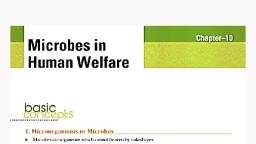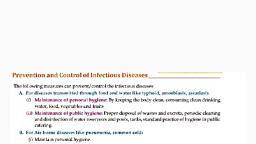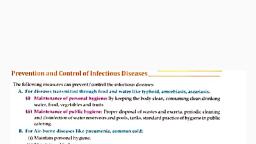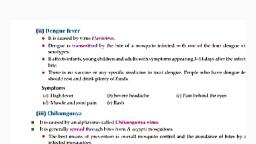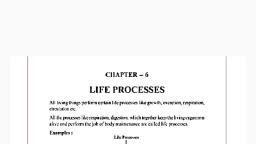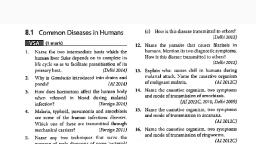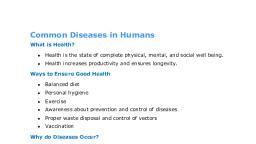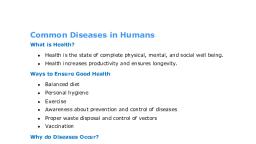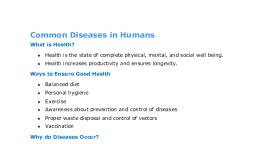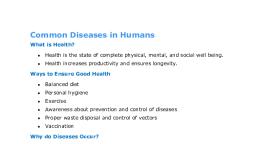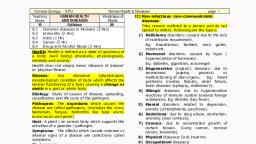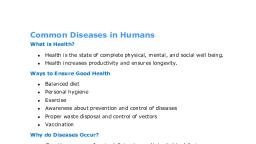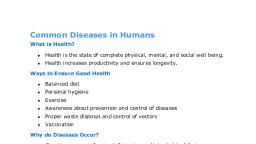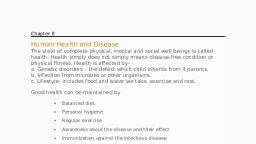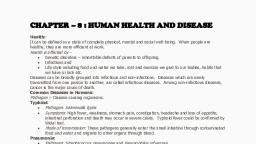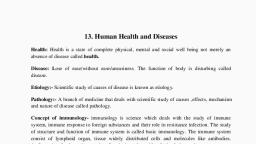Page 1 :
T5. ACquired, , It, It, , immuno, , >ynrome, , Deiciency, , [AlDS)-, , was first reported in U.S.A. in 1981 and in last 25 years, it has killed more than 25 million people., , is caused by the Iuman Immunodeficiency Virus (1ITV., 1IIV beloangs to the grup retroviru,, It has RNA genome enclosed in an envelope., ot ltV occurs through tollowing ways:, Transmission, (i) By sexual contact with the infected person., (i) By trarnwfusion of contaminated blood and blood products., (iir) By sharing infected nerdes., , From infected mother to her child through placenta., spread by more touch or physical contact. It only spreads through body fluids. Hence the, infected persons should not be isolated from family and soiety., (), , It, , is not, , High risk individuals, ) Those having multiple sexual partner, (i) Drug addicts taking the drugs intravenously., (ii) Individuals who require repeated blood transfusions., (io) Children born to an 1V infected mother., Human Health and Diseases 301, , linked immunosorbent assay (ELISA)., Time, gap, between infection and appearance of AlDS symptoms is called the, Period:, Incubation, incubation period. lt may vary trom lew months to 5-10 years., Diagnosis, , is done by enzyme, , Life cycle of HIV, getting into the body of a person, the virus enters the macrophages., RNA is replicated to form viral DNA by enzyme reverse transeriptase, , After, Ilere,, , The viral DNA now gets incorporated into the host cell's DNA and directs the inferted cells to, produce virues., The macrophages continue to produce virus particles and hence act like 1|V factory., The virus particles enter helper T-lymphocytes (Ti cells) in the bloox, where they continue to, replicate and produce viral progenie, the number of helper T-lymphocytes progressively decereases in the body of the infected, Thus,, peTsons., Ketovirus, , Viral RNA core, , ira infects, ormal cell, , Viral protein, coat, , Plasmia, , ce, , Animal, Viral RNA Is introduced into cel, , Cytoplssm, Viral DNA is, , produced, reversBe, ranscriptase, , Oy, , Viral DNA incorporates, into host gernone, , New vira RNA, , he infected cel, New, , viruses, , are produced, , Nucteus, , New, , ONA, , vinuses, , can Intect other cels, Fg. 8.4 Repicaion of retrorus, , the immunity also decreases. The person is unable ta, even against common bacteria like Mycobacterum, parasites like, immune, Toxoplasma, viruses and fungi., Infected cells can survive while viruses are being replcated and released., decrease in number of Tcells,, With the any, response, , produce, , Treatment, There, , is, , no permanent cure for 1 IV., drugs: They can only proong lite of patient but cannot prevent death., , Anti-retroviral, , 302 Xam idea Biology-X
Page 2 :
B.3: AIDS TAcquired Immuno DeficiencY SYndro mel., This refers to an acquired condition of deficiency of immune system. It is a condition acquired during the lifetime af an, individual referring to the fact that it is not a congenital disease. 'Syndrome' means a group of symptams., AIDS was first reported in 1981 and, more than 25 million person5., , in, , approximately the last twenty-five years, it has spread all over the warld killing, , Causative Agent The Human Immuno deficiency Virus (HIV), tls a member of a group of viruses called retrovirus. They have an envelope enclosing the RNA gename. They also contain, the reverse transcriptase gene., , m, , A, , w, , Cepsd), , ww, , wwc, , tid, , te, , ar, , utee*, , Transmisslon of HIV-infection, (a) Sexual car, with infected person, (b) By transusion of contaminated blood and blood products,, (c) By sharing infected needles as in the case of intravenous drug, (o) From infected mother to her child through placenta., , abusers, , and
Page 3 :
14. Immune System, Components, , of immune system:, Lympheoid organs, , Immune cells, Soluble, , ymphid, , moecules like antibodies, tissues, Lymphold organs, , Primary lymphoid organs, , Secondary ymphoid organs, , (i) Primary lymphoid organs, organs where lymphocytes originate and mature to become antigen-sensitive, rg, bone, marrow and thymus, are called primary lymphoid organs where immature iymphocytes, ditterentte, into anugen sensitive lymphocytes., , The, , 300 Xam idlea Biology-X, , (a) Bone marrow, , It, , the primary lymphoid organ where all bloond cells including lymphocytes originate., Bone marrow provides the micro-environment for the development and maturation of, is, , -Iymphocytes, (b) Thymus, , is a lobed organ located near the heart and beneath the breastbone., Thymus, It is quite large at the time of birth but reduces with age., It, provides the micro-environment or the development and maturation of T-lymphocytes., , (ii) Secondary lymplhoid organs, Iymphocytes migrate to secondary lymphoid organs., The organs where lymphocytes interact with the antigen and proliferate to become effector cells,, lymph nodes, tonsils, Peyer's patches of small intestine and appendix are called, spleen, lymphoid, ondary, organs., After, , maturation,, , (a) Spleen, , bean-shaped organ and contains lymphocytes and phagocytes., of the blood by trapping blood-borne microorganisms., It acts, It, has a large reservoir ot erythrocytes,, (b) Lymph nodes, These are small sohd structures present at different points along the lymphatic system., They trap the microorganisms or other antigens that enter the lymph and tissue fluid., Antigens, trapped in the lymph nodes activate the lymphocytes and produce an immune response., It, , is a large, , as a filter, , (c) Mucosal associated Iymphoid tissue (MALT), is formcd of masses of lymphoid tissue lining the mucosa of respiratory, digestive and, urinogenital tracts., 50) per cent of the lymphoid tissue in human body is formed by MALT., , It
Page 4 :
(ii) Types of cancer, Carcinoma: It is cancer of epithelial tissue, eg, skin cancer., (), NMelanama: It is cancer of melanxytes of skin., It is cancer of mesndermal tissue., Sarcoma:, ( Leukemia and lymphoma: It is cancer of haemopoietic cells (blood cells)., (a), , (ii) Cancer detection, marrow tests are done tor increased cell count in case of leukemia., (), listopathological study or biopsy: In biopsy, a piece of the suspected tissue cut into th, sections is stained and examined under micronccope by a pathologist., e) Radiography: X-rays are used to detert cancer of the internal organs., (a), , Blood and bone, , Computed, , tomography:, , It uses, , Xrays to generate a three-dimensional image of the internal, , an obyect., , e, , MRI Magnetic Resonance imaging: Non-ionising radiation and stromg magnetic field a, in MRI to aceurately detect pathological and physiological changes in the living tissue., Monoclonal antibodies: Antibodies against cancer-specific antigens are abo ued for detecti, , ud, , ot certalin canes., (e) Techniques in molecular biology: Usd to detect genes in individuas with inherited sueptibil, to certain cancers. ldentification of such genes can help in prevention by advising to avc, epoure to particular carcinogen to which they are susceptible ike tobacco smoke tor lung cand, , (iv) Cancer treatment, common approaches for treatment of cancer are:, (a) Surgery: The tumour cells are removed with the help of surgery to check the spread ofcancera, cells, (6) Radiation therapy: A lethal irradiation of umour cell is done, taking proper care of the norm, issues surrounding the tumour mass., e) Chemotherapy: Cancerous cells are killed by several chemotherapeutic drugs. These dru, , The, , exhibit sideettects, , like hair loss, ansemia., , an Immunotherapy: In this, , like a-interterons are used whi, activate the immune system and help in destroying the tumour as tumor cells avoid deterti, and destruction by immune, system. Majority of treatments require combination of surge, radiotherapy, and chemotherapy., methoxd, biological moditiers








